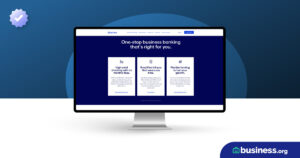💸 See if your business qualifies for a tax credit worth up to $26k per employee. 📞 Call Now: 855-979-9597
When Are Business Taxes Due in 2023?
We are committed to sharing unbiased reviews. Some of the links on our site are from our partners who compensate us. Read our editorial guidelines and advertising disclosure.
If you’re a sole proprietor or owner of a C corporation, your business taxes for the 2022 tax season are due by midnight on April 18, 2023.
If your business is a partnership or S corporation, your business taxes are due no later than March 15, 2023.
Ready to start filing your small business’ taxes? Check out a list of the best tax software of the year for business owners. Each of the tax software options we review on the page, from Liberty Tax to TurboTax, can help you file your taxes on or before this year's tax-filing deadline.

- Get better accounting software. Quickbooks is our top pick for businesses looking for comprehensive features that simplify tax season.
- Outsource your bookkeeping. Merritt Bookkeeping's affordable outsourced bookkeeping saves business owners time and money.
- Opt for all-in-one business checking. Found is the perfect match for teams of one looking for smart tax tools.
Business tax deadlines
If you file business taxes as a sole proprietor, own a C corporation or employ one or more household workers (like a nanny or in-home nurse), your business tax-filing deadline is April 18, 2023.
Note that this year’s tax deadline falls on a Tuesday. That’s because April 15, which is the typical deadline, is on a Saturday this year and Monday, April 17, is a holiday in Washington, D.C.
If your business is classified as a partnership or S corporation, your business taxes are due a month earlier on March 15, 2023 (which falls on a Wednesday). Multi-member LLCs should also file by this deadline.
For more information and advice specific to your business, talk to your accountant and consult IRS Publication 509. This publication breaks down the IRS’ year-long tax calendar and provides more detail on tax-filing extension deadlines, tax forms and more.
Business structures
The Internal Department of Revenue (IRS) requires different forms, rates, and filing dates depending on the official business entity of your company.
Sole proprietorship
In this type of structure, a business owner keeps their business assets and personal assets tied together, so a sole proprietor pays taxes as part of their personal income tax return. If you don’t register your small business as any particular type, a sole proprietorship is the default structure.
Partnership
Like a sole proprietorship, a partnership also pays taxes as part of each partner’s personal income tax return. But unlike an LLC, partners are still liable for any business debts.
Limited liability company (LLC)
When it comes to federal taxes, an LLC functions much like a partnership would. But a small business can file with its state to be organized as an LLC as long as it meets the requirements.
S corporation
An S corporation complies with some of the typical corporate obligations and issues (such as passive income tax and built-in gains tax). But an S corporation is generally smaller, and the owners must pay taxes on their portion of the business income as part of their personal tax return.
C corporation
Once your company is fully incorporated, a C corporation structure is the default option. C corporations file and pay a corporate tax return instead of passing income onto the owners’ personal taxes.
By signing up I agree to the Terms of Use and Privacy Policy.
Tax forms
Now that you have an idea of what the business entities are and how to get an extension on your tax return, let’s dive further into the forms you need for filing.
Sole proprietors and single-owner LLCs
If you own a sole proprietorship—or if you’re the only owner of your LLC—then you’ll simply need to file Schedule C as part of your Form 1040, which is the form you file with your personal tax return.
Partnerships, S corporations, and multi-owner LLCs
Partnerships, S corporations , and LLCs with multiple owners need to fill out Form 1065. These businesses pass profits (or losses) through to the business owners, who report their earnings on Schedule E on the 1040 Form. They should receive a Schedule K-1 form to help them fill out Schedule E.
C corporations
C corporations should file their corporate taxes with Form 1120. Owners receive a Form 1099-MISC to report any dividends on their personal income tax returns.
Additional forms
If you own a business with employees, you’ll need to file Form 941 along with the payroll taxes you withhold from employee paychecks and remit directly to the IRS. (You should remit these taxes quarterly, also with Form 941.) Note that household employers are also required to withhold payroll taxes, so they also need to file Form 941.
If your business is subject to any excise taxes, you’ll need to file Form 720. Finally, if your state has a sales tax, you’ll need to fill out a state form for a sales tax return. You can find information on your state’s tax requirements via the IRS’s list of state government websites.
Quarterly vs. annual payments
Wondering if your business should pay taxes quarterly or annually? If your business has employees, you’ll need to file Form 941 (along with your employees’ payroll taxes) every three months. You will also need to pay a quarterly tax if your business sells specified goods, like gasoline or alcohol, that require an excise sales tax.
If your business doesn’t fall under those categories, figure on paying at the usual tax time. But if you’re worried about having a large sum of cash on hand to make a lump-sum annual payment, consider paying quarterly instead. Additionally, freelancers are required to pay estimated quarterly taxes and to file an end-of year tax return.
All quarterly estimated tax payments for individuals, S corporations, and C corporations, should be made on the following schedule:
- January 16, 2023 (final estimated tax payment for the 2022 tax year)
- April 18, 2023 (first estimated tax payment for the 2023 tax year)
- June 15, 2023 (second estimated tax payment for the 2023 tax year)
- September 15, 2023 (third estimated tax payment for the 2023 tax year)
C Corporations will make their final estimated quarterly tax payment on December 15, 2023. Individuals and other types of corporations can wait until January 2024 to file their fourth quarterly payment for the 2023 tax year.
Deductions and refunds
While you can deduct many different business expenses from your tax liability, not every business will receive a tax refund. Unlike an employee’s income, which has a part of every paycheck withheld for taxes, a business owner or independent contractor has no automatic system in place. But an accountant or tax software can help you estimate taxes beforehand to make sure you’re covering your expected taxes with quarterly payments.
Technically, only a C corporation can receive a refund for the business itself. But owners of pass-through entities (LLCs, sole proprietorships, S corporations, and partnerships) can receive personal tax returns if their income tax and self-employment taxes are smaller than their tax payments and deductions. In other words, you get a return if your business overpays on your estimated tax payments throughout the taxable year.
If you do get a refund, you can expect it about three weeks after you file. So it makes sense to get started on your business tax return right away—save yourself time spent worrying and get your refund earlier if you’re eligible.
The Employee Retention Tax Credit (ERC) is a tax credit available to employers who successfully kept their workers employed during portions of the COVID-19 pandemic. Find out if you qualify for the tax credit and get started on your application to get up to $26,000 reimbursed per employee.
The takeaway
Tax season always seems to arrive sooner than you’d like. But now that you know when business taxes are due in 2023, we hope you’ll feel more confident heading into tax season. You can do this.
Want help filing taxes on time? Check out our list of the year’s best online tax-filing software for small businesses.
Related content
Business tax-filing deadlines FAQ
C corporations need to file by April 18, 2023 using form 1120. For partnerships, S corporations, and multi-member LLCs, you need to file by March 15, 2023 using form 1065 or 1120S.
If you can't file your taxes by the April 18 deadline, you can instead request a tax-filing extension that extends your paperwork deadline by six months. For C corporations and sole proprietors, your new tax deadline will be October 16, 2023 with the extension.
Bear in mind that an extension only extends the time period for filing paperwork. Your tax payments are still due no later than the 18th, though you can work with the IRS to build a payment plan if you can't pay taxes immediately.
Disclaimer
At Business.org, our research is meant to offer general product and service recommendations. We don't guarantee that our suggestions will work best for each individual or business, so consider your unique needs when choosing products and services.




